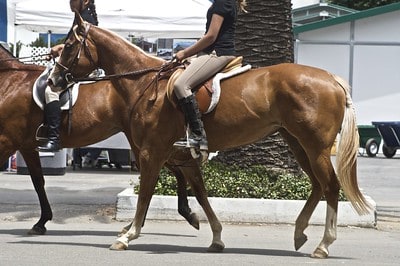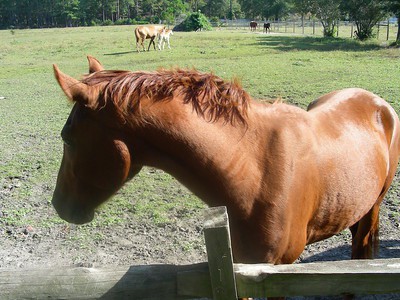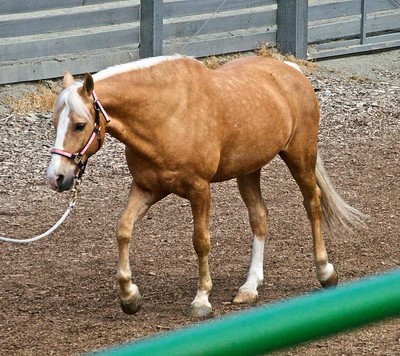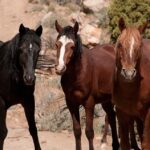Chestnut is a popular horse color and is characterized by a reddish-brown coat and lighter mane and tail. Let’s learn more about flaxen chestnut horses.
Flaxen chestnut horses carry the flaxen trait as a result of which their coat is brown or liver-brown, but their mane is of a much lighter color, usually light or dark blonde. Some horses carrying the flaxen trait may sometimes have cream, orange, or yellow-coloured mane and tail.
Key Takeaways
| Topic | Summary |
|---|---|
| Chestnut Horses | Chestnut horses have a reddish-brown coat with no black hairs. Some breeds like Haflingers and Suffolk Punch are purely chestnut. |
| Chestnut with Flaxen Mane and Tail | A chestnut horse with a flaxen mane and tail has a typical chestnut coat but a light-colored mane and tail, often brown with blonde shades, known as sorrel in some stock horse breeds. |
| Causes of Flaxen Chestnut | Flaxen chestnut is caused by the flaxen gene, passed down from generation to generation. Some horses have light-colored manes and tails due to dilution genes, distinct from flaxen chestnuts. |
| Flaxen Mane and Tail | Flaxen mane and tail are lighter in color and common in chestnut horses. They indicate the presence of the flaxen gene, giving a blonde or dark blonde hue to the mane and tail. |
| Sorrel vs. Chestnut | Sorrel horses have a red base coat with possible white markings, while chestnuts can be any shade of red with flaxen manes and tails; if mane and tail are black, it’s chestnut. |
| Flaxen Sorrel Horse | A flaxen sorrel horse has a light red coat with a yellow or straw-colored mane and tail, distinct from the typical chestnut color. |
| Flaxen Thoroughbreds | Thoroughbreds with a chestnut coat can have flaxen manes and tails, giving them a golden-yellow appearance. Bay or black-coated thoroughbreds do not carry the flaxen gene. |
| Flaxen Chestnut Quarter Horse | American Quarter Horses with chestnut coats can also exhibit flaxen manes and tails, with mane and tail colors ranging from light to dirty blonde or even orange. |
| Common Breeds with Flaxen Trait | Common horse breeds with the flaxen trait include Haflingers, Quarter Horses, Black Forest Horses, Oberlander, Italian Draft Horses, Jutland, and Morgan Horses. |
| Differentiating Palominos from Flaxen Chestnut | Palominos have white or cream-colored manes and tails, while flaxen chestnuts have reddish hairs in their mane and tail, due to distinct genetic traits. |
The flaxen gene is passed down from parent to offspring and is a subject of much discussion in the equine world. Allow us to take you through some commonly asked questions about flaxen chestnut horses.

What is a chestnut horse?
Before we can analyze what flaxen chestnut is, it is essential to know more about chestnut horses. So, let’s get started.
Chestnut horses have a red or reddish-brown coat with no trace of black hairs. Horse breeds such as Haflingers and Suffolk Punch are purely Chestnut, and breeding between two chestnut horses is likely to produce an actual breed of the same coat color. Some chestnuts also have primitive markings like most horses.

What is a chestnut with flaxen mane and tail?
Chestnut horses are characterized by their reddish-brown coat. But, some have a flaxen mane and tail. Let’s see what they’re called.
A chestnut with a flaxen mane and tail is a horse with a typical chestnut coat but a light-colored mane and tail. These horses are usually brown or reddish-brown, but their mane and tail are brown with a dirty-blonde or clear blonde mane. This color is referred to as sorrel in the case of stock horse breeds.
It is worth mentioning that flaxen mane and tail is a distinct characteristic of chestnut horses and doesn’t extend to horses with bay or black coats.
What causes flaxen chestnut?
Flaxen chestnut horses are pretty unique, with a gorgeous blonde or dark blonde mane and tail. Let’s find out what causes flaxen chestnut.
Flaxen chestnut is caused by the flaxen gene. This color pattern is called the ‘flaxen trait” and is passed down from one generation to another. There have been cases of chestnut horses who do not exhibit the prevalence of a strong flaxen gene but have nonetheless produced offspring with a strong flaxen trait.
Often, horses with a lighter mane and tail may be mistaken for flaxen chestnuts. However, some horses have light-colored mane and tails due to a genetic mechanism known as dilution genes.
What is a flaxen mane and tail?
The term flaxen mane and tail is often heard in the context of chestnut horses. But, what is it? Let’s find out.
Flaxen mane and tail are commonly found on chestnut horses and indicate the presence of the flaxen gene in the horse breed. This flaxen trait lends a golden-blonde or dark-blonde shade to the mane and tail of chestnut horses who otherwise have a brown, reddish-brown, or liver-brown coat.
This lighter coloring present on chestnut horses is dubbed as ‘flaxen’ by horse breeders and scientists.
Sorrel vs. Chestnut
Sorrel and Chestnut horses have a similar appearance and it might be difficult to distinguish between the two colorings. Let’s learn the major difference between them.
Sorrels have a red base coat with possible white markings. They can have a flaxen mane and tail but no trace of black coloring. Chestnuts can be any shade of red, ranging from light to liver red with flaxen mane and tail. If their mane and tail appear black, the horse is characterized as chestnut.
All in all, the primary difference between sorrels and chestnuts lies in the absence of black markings. Sorrels are exclusively light-colored.
What is a flaxen sorrel horse?

A flaxen sorrel is slightly different from the typical flaxen chestnut. Allow us to tell you more about it.
A flaxen sorrel horse has a light red or copperish-red coat with a yellow-colored or straw-colored mane and tail. This copper-red color without any hint of black is among the most common color patterns, and you’ll find several horse breeds with it. However, it is slightly different from the typical chestnut hue.
A sorrel horse that comes with a flaxen mane and tail is often referred to as chestnut flaxen as well, especially in the United States.
Can Thoroughbreds be flaxen?
Thoroughbreds can be black, bay, or chestnut. But, can the chestnut variety of thoroughbreds be flaxen? Let’s find out.
Thoroughbreds that have a chestnut coat (be it liver-chestnut, red, or gold chestnut) can be flaxen. In this case, their mane and tail will be golden-yellow with shades of chestnut. However, thoroughbreds that have a bay or black coat do not carry the flaxen gene.
Flaxen Chestnut Quarter Horse
The American Quarter Horse is known for its speed and agility. Let’s check out whether they have a flaxen mane and tail.
American Quarter Horses that have a chestnut coat can also contain flaxen mane and tail. These horses have 17 different color types, and out of these, the brownish-red coat that characterizes sorrel horses is the most popular. The mane and tail can be either light or dirty blonde and sometimes even orange.
A large percentage of American Quarter Horses have a chestnut coat, and it is easy to spot a flaxen chestnut horse.
What are some common breeds of flaxen chestnut horses?
Flaxen chestnut horses have a very interesting genetic characteristic that gives them a unique coloring. Let’s check out some common breeds of flaxen chestnut horses.
Some common breeds of horses that carry the flaxen trait include Haflingers, Quarter Horses, Black Forest Horses, Oberlander, Italian Draft Horses, Jutland, and Morgan Horses. However, it is worth noting here that most chestnut horses have the same color from mane to tail and do not inherit the flaxen trait.
How to differentiate between Palominos and Flaxen Chestnut?

Both palominos and flaxen chestnut horses have a light-colored mane and tail and darker bodies. So, how does one differentiate between them? Let’s find out.
Chestnut horses with flaxen have reddish hairs in their mane and tail, which distinguishes them from other horse colors. Palominos are created through dilution genes, and their mane and tail are either white or cream-colored as opposed to the light or dark blonde coloring of flaxen chestnuts.
The flaxen trait in chestnut horses is genetically passed down and not created through dilution technique.
Conclusion
Horses are intriguing creatures that tell us a lot about the equine kingdom and how genetics functions within it.
Flaxen chestnuts are gorgeous horses that inherit their color due to the presence of two separate genes. There is much discussion and debate about how the flaxen gene works and whether it can be passed down to the bay or black horses. Numerous possibilities are being explored in this regard, but nothing concrete has been found yet.




